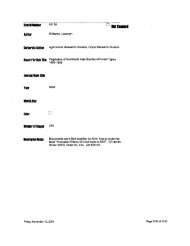Epidemiologic Investigation of Health Effects in Air Force Personnel ...
Epidemiologic Investigation of Health Effects in Air Force Personnel ...
Epidemiologic Investigation of Health Effects in Air Force Personnel ...
Create successful ePaper yourself
Turn your PDF publications into a flip-book with our unique Google optimized e-Paper software.
(see below and Section VI). Also, many <strong>of</strong> the RANCH HAND aircraft were reconfigured<br />
for transport and <strong>in</strong>secticide missions and thus, the non-RANCH HAND<br />
C-123 crews responsible for these other missions may have been exposed to<br />
significant Herbicide Orange residue <strong>in</strong> these aircraft. Therefore, this group<br />
may not have been truly unexposed to herbicides, and was discarded as an<br />
appropriate control population. Crewmembers <strong>of</strong> C-7 transport aircraft were<br />
also considered as a potential control group; however, because <strong>of</strong> small sample<br />
size (1000-2000) and the fact that they served <strong>in</strong> RVN only dur<strong>in</strong>g the post<br />
1967 era, they were also dropped from consideration.<br />
The normal crew composition <strong>of</strong> a C-130 is three <strong>of</strong>ficers and two<br />
enlisted personnel. The control group is considered to be "pure" from the<br />
standpo<strong>in</strong>t <strong>of</strong> lack <strong>of</strong> occupational exposure to herbicide. The entire control<br />
group will be considered "nonvolunteer" with respect to abnormally high combat<br />
risk. While <strong>in</strong> general they will possess lifestyle characteristics and socioeconomic<br />
backgrounds similar to the exposed group, their overall combat<br />
morbidity/mortality and the resultant stress <strong>in</strong>fluences upon general health<br />
may be slightly less than <strong>in</strong> the exposed group. For those separated and<br />
retired C-130 controls, similar proportions to the exposed group are expected<br />
to be employed <strong>in</strong> the aerospace <strong>in</strong>dustry. Known and estimated factors <strong>of</strong> the<br />
control and exposed populations are summarized <strong>in</strong> Table 5.<br />
(3) Match<strong>in</strong>g Procedures and Rationale<br />
Each member <strong>of</strong> the exposed group has been computer matched to a<br />
set <strong>of</strong> C-130 controls comprised <strong>of</strong> approximately 10 <strong>in</strong>dividuals us<strong>in</strong>g three<br />
variables. S<strong>in</strong>ce the u;o groups are highly selected and <strong>in</strong>herently similar<br />
with respect to many variables, very close matches are feasible. This<br />
epidemiologic design <strong>in</strong>corporates a matched concept because: (1) a matched<br />
cohort design will provide maximum test power throughout the entire study, and<br />
(2) statistical <strong>in</strong>tergroup comparisons may be made without normalization by<br />
three key variables known to effect symptom frequencies <strong>of</strong> <strong>in</strong>terest, thus<br />
provid<strong>in</strong>g greater power for complex statistical test<strong>in</strong>g. It is apparent that<br />
follow<strong>in</strong>g the match, both exposed and control populations will be very nearly<br />
identical with respect to the three <strong>in</strong>fluenc<strong>in</strong>g variables so that a replacement<br />
concept is feasible (see F below). In the event that frequent match<br />
breaks occur, stratification techniques can be used.<br />
The selection <strong>of</strong> the control group produces an <strong>in</strong>herent match for<br />
equivalent SEA experience, and additional match<strong>in</strong>g has been conducted for (1)<br />
age, by year <strong>of</strong> birth and closest month possible, (2) <strong>Air</strong> <strong>Force</strong> Speciality<br />
Code (AFSC) as an absolute match, and (3) race (Caucasian versus non-<br />
Caucasian) as an absolute match. Specific rationale for these variables is as<br />
follows: (1) the age match controls for the many cl<strong>in</strong>ical symptoms and signs<br />
associated with advanc<strong>in</strong>g age, (2) AFSC controls for <strong>of</strong>ficer-enlisted status<br />
(as well as crewmember-noncrewmember status), a variable strongly l<strong>in</strong>ked to<br />
educational background, current socio-economic status, and moderately l<strong>in</strong>ked<br />
to age (5 year median difference) and socio-economic background, and (3) race<br />
controls for differences <strong>in</strong> chronic disease development, socio-economic background,<br />
etc.<br />
22
















